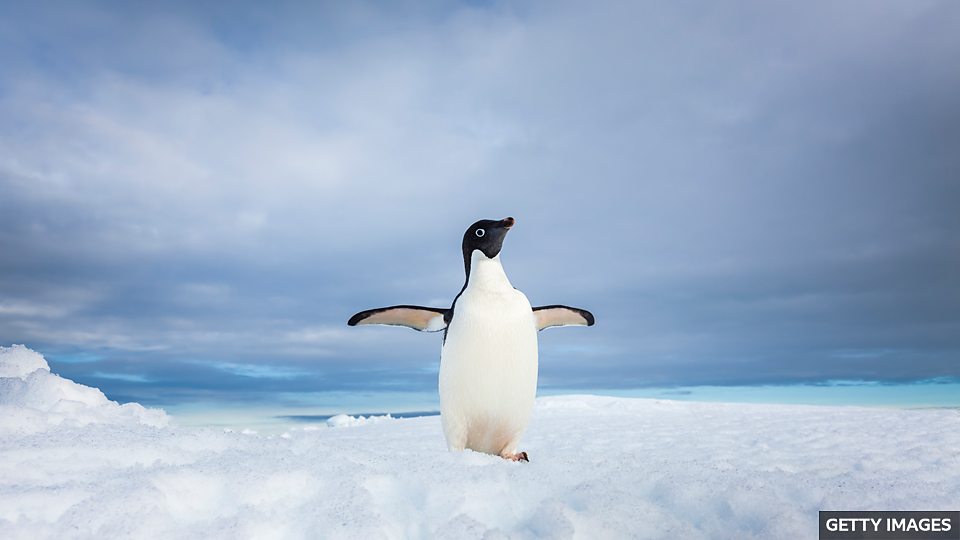本集内容
Antarctica penguins: How too much ice triggered population decline 坚冰过多导致南极企鹅数量剧减
文字稿
How is ice bad for penguins?
冰怎么会对企鹅有害呢?
A new study has revealed a 43% decline in Adélie penguins across 52 sites off east Antarctica over the last decade.
一项新研究发现,在过去十年中,在南极东部52个聚居地生活的阿德利企鹅数量减少了43%。
But what triggered the decline? Too much fast ice.
而造成企鹅数量减少的原因是过多的坚冰。
Dr Louise Emmerson, Australian Antartic Division
"So, fast ice is a layer of ice over the ocean between the open water and their breeding sites. That can be up to 80km.
露易丝·埃莫森博士 澳大利亚南极局
“坚冰是在海洋上的一层冰,介于开放水域和这些企鹅的繁殖地之间。坚冰覆盖区域可长达80公里。”
Too much fast ice results in a very long trip to the ocean for food.
坚冰过多导致企鹅需要长途跋涉才能到海中觅食。
Dr Louise Emmerson, Australian Antartic Division
"In years where there's that extensive fast ice near the breeding colony, the adults have a lot of trouble feeding the chicks often enough."
露易丝·埃莫森博士 澳大利亚南极局
“在企鹅繁殖栖息地周边大面积被坚冰覆盖的年份里,成年企鹅很难照常定期给自己的雏鸟喂食。”
If the chicks aren't fed regularly, then they will die.
如果雏鸟不能定期得到喂食,它们就无法存活。
Dr Louise Emmerson, Australian Antartic Division
"Between 2003 and 2008, there was a lot of very extensive fast ice, and it was during that period that there were virtually no chicks that survived."
露易丝·埃莫森博士 澳大利亚南极局
“在2003年至2008年间,坚冰覆盖的区域面积非常大,也正是在那段时间内,几乎没有雏鸟幸存下来。”
But does climate change mean there is less ice?
不过,气候变化是否意味着坚冰变少?
Dr Louise Emmerson, Australian Antartic Division
"So even though overall there is a reduction in that fast ice around Antarctica, we don't understand why it's so patchy or what has caused an increase in this particular area."
露易丝·埃莫森博士 澳大利亚南极局
“尽管南极周围的坚冰总体上有所减少,但我们不清楚为什么坚冰的分布如此不均匀,也不明白是什么导致了这一区域的坚冰有所增加。”
After 2008, the ice receded, but the population continued to decline. Fewer fledglings were leaving the breeding site together, which reduced their chances of surviving their first winter at sea.
2008年之后,坚冰有所消退,但是企鹅的数量还在继续减少。可以结伴离开繁殖地的幼鸟数量更少了,这降低了它们在海上活过第一个冬天的机会。
Dr Louise Emmerson, Australian Antartic Division
"The decline is actually very, very significant. We think it's because of this feedback process between population size, reduced breeding success and reduced fledgling survival that has just made that decline far more rapid than we would've expected if any one of those things were operating in isolation."
露易丝·埃莫森博士 澳大利亚南极局
“企鹅的数量真的大幅减少。我们认为这是几个因素循环作用导致的,包括企鹅群基数减少、繁殖成功率下降和幼鸟成活率降低。这使得企鹅数量减少的速度远远超过我们的预期,预期中假设只有以上提到的某一个因素单独起作用。”
Scientists are unsure if the population will be able to recover.
科学家们不确定企鹅的数量是否还能恢复。
Dr Louise Emmerson, Australian Antartic Division
"We're hopeful that with a few years where they've got good breeding success that maybe this population can turn around this negative decline. But we're really not sure yet – it depends on the environmental conditions that they're going to experience in the future, and of course we don't know that at this stage."
露易丝·埃莫森博士 澳大利亚南极局
“我们抱有希望,如果连续几年繁殖成功率喜人,也许阿德利企鹅种群总数的恶性减少可以被扭转。但我们现在无法确定,因为这取决于企鹅在未来将面临的自然环境条件,而这是现阶段我们无法得知的。”

